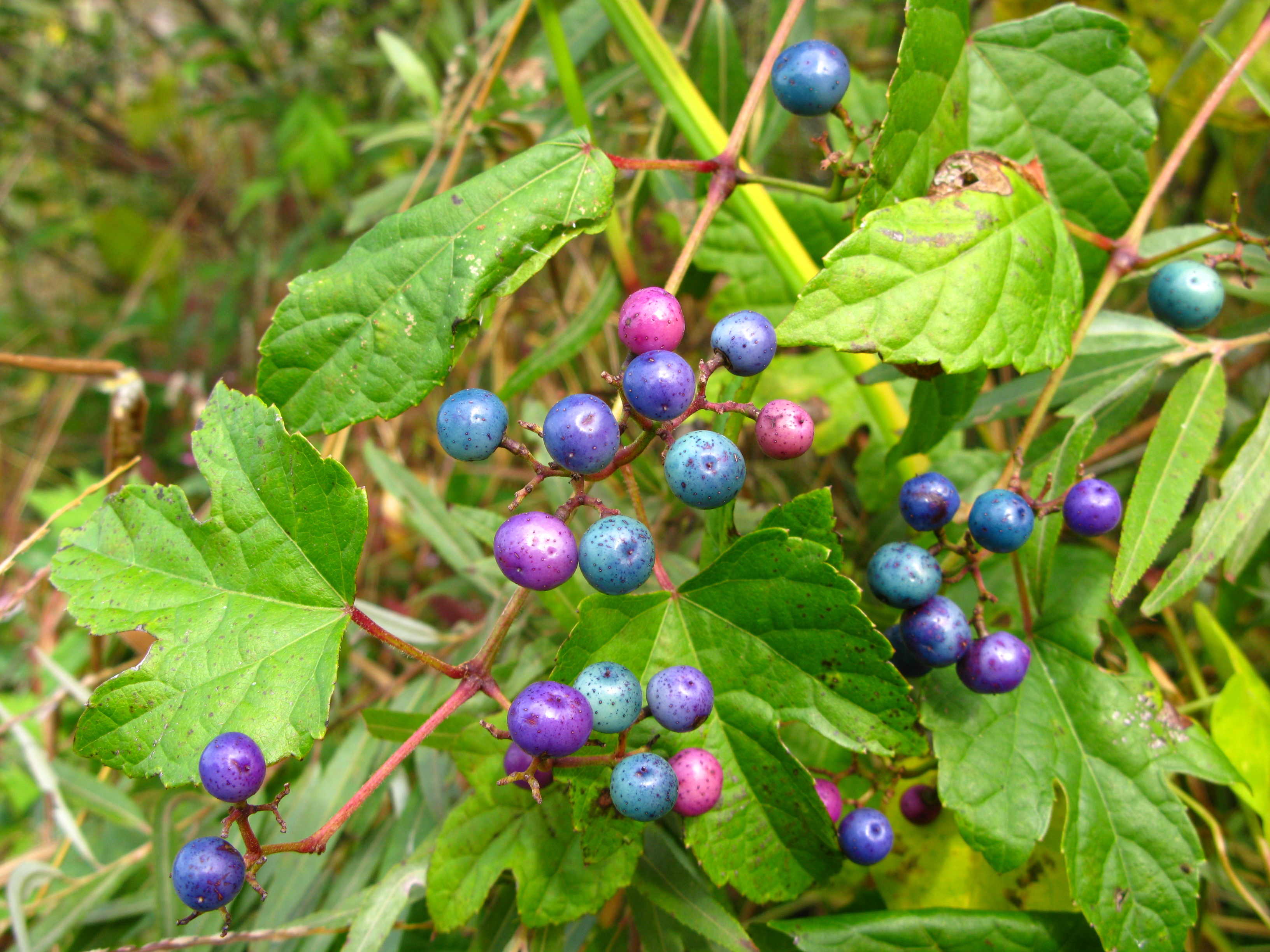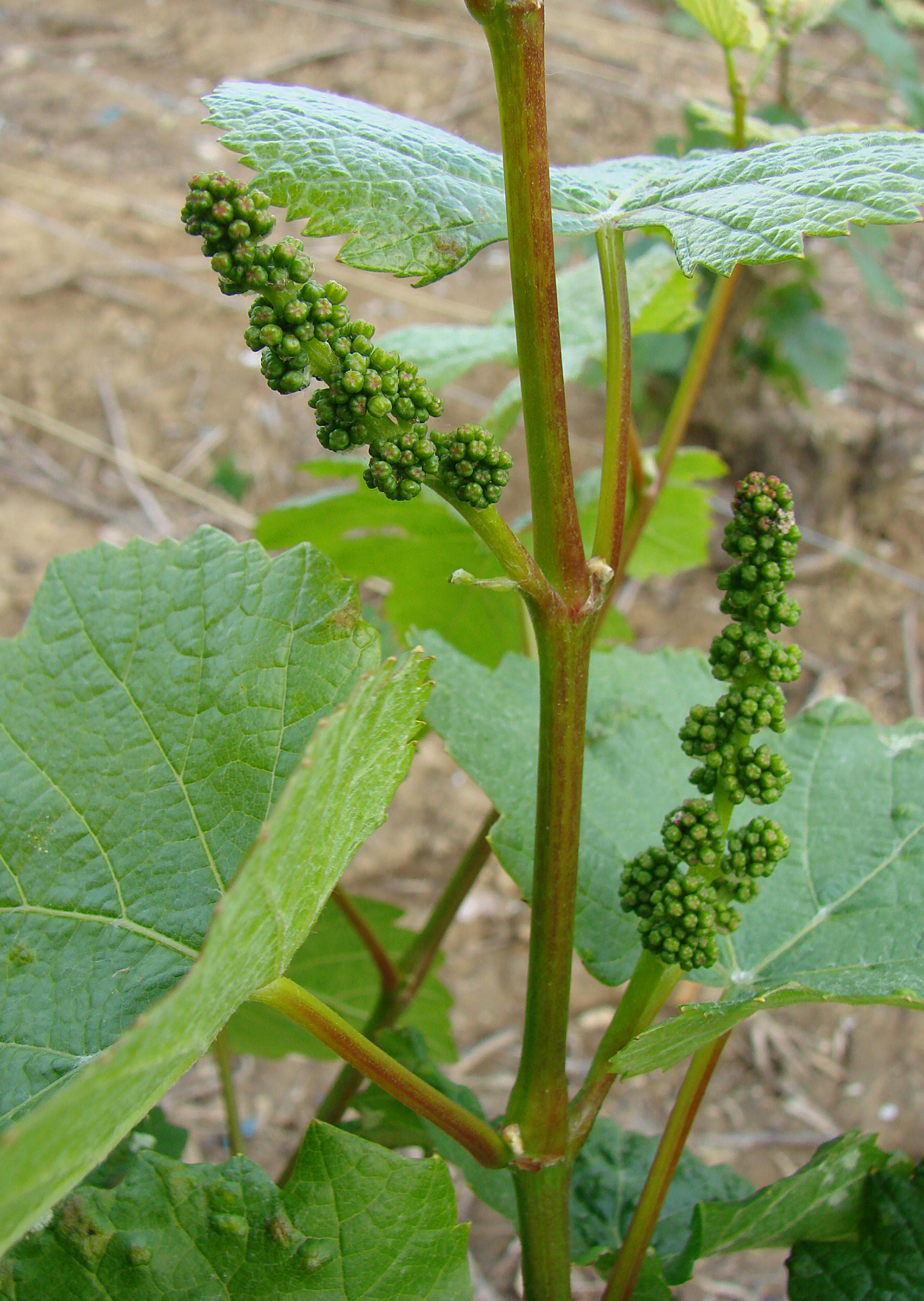|
Vitaceae
The Vitaceae are a family of flowering plants, with 14 genera and around 910 known species, including common plants such as Vitis, grapevines (''Vitis'' spp.) and Parthenocissus quinquefolia, Virginia creeper (''Parthenocissus quinquefolia''). The family name is derived from the genus ''Vitis''. Most ''Vitis'' species have 38 chromosomes (n=19), but 40 (n=20) in subgenus ''Muscadinia'', while ''Ampelocissus'', ''Parthenocissus'', and ''Ampelopsis'' also have 40 chromosomes (n=20) and ''Cissus'' has 24 chromosomes (n=12). The family is economically important as the Berry (botany), berries of ''Vitis'' species, commonly known as grapes, are an important fruit crop and, when fermented, produce wine. Species of the genus ''Tetrastigma'' serve as hosts to parasitic plants in the family Rafflesiaceae. Taxonomy The name sometimes appears as Vitidaceae, but Vitaceae is a conserved name and therefore has priority over both Vitidaceae and another name sometimes found in the older literat ... [...More Info...] [...Related Items...] OR: [Wikipedia] [Google] [Baidu] |
Leea
''Leea'' (Tagalog language, Tagalog: ''Talyantan'') is a genus of plants in the family Vitaceae, subfamily Leeoideae, that are native to parts of central Africa, tropical Asia, Australia and Melanesia. It was previously placed in its own family, Leeaceae, based on morphological differences between it and other Vitaceae genera. These differences include ovule number per locule (two in Vitaceae and one in Leeaceae), carpel number (two in Vitaceae and three in Leeaceae), and the absence or presence of a staminoidal tube (present in Leeaceae) and floral disc (present in Vitaceae). Pollen structure has also been examined for taxonomic demarcation, though studies have concluded that the pollen of Leeaceae and Vitaceae suggests the families should remain separate while other studies conclude that ''Leea'' should be included in Vitaceae. The genus was named by Carl Linnaeus, Linnaeus after James Lee (nurseryman), James Lee, the Scottish nurseryman based in Hammersmith, London who introduc ... [...More Info...] [...Related Items...] OR: [Wikipedia] [Google] [Baidu] |
Tetrastigma
''Tetrastigma'' is a genus of plants in the grape family, Vitaceae. The plants are lianas that climb with tendrils and have palmately compound leaves. Plants are dioecious, with separate male and female plants; female flowers are characterized by their four-lobed stigmas. The species are found in subtropical and tropical regions of Asia, Malaysia, and Australia, where they grow in primary rainforest, gallery forest and monsoon forest and moister woodland. Species of this genus are notable as being the sole hosts of parasitic plants in the family Rafflesiaceae, one of which, '' Rafflesia arnoldii'', produces the largest single flower in the world. ''Tetrastigma'' is the donor species for horizontal gene transfer to '' Sapria'' and '' Rafflesia'' due to multiple gene theft events. Within the Vitaceae, ''Tetrastigma'' has long been considered closely related to '' Cayratia'' and '' Cyphostemma'' and is now placed in the tribe Cayratieae. Fossil record A fossil seed fragmen ... [...More Info...] [...Related Items...] OR: [Wikipedia] [Google] [Baidu] |
Clematicissus
''Clematicissus'' is a genus of flowering plants in the family Vitaceae The Vitaceae are a family of flowering plants, with 14 genera and around 910 known species, including common plants such as Vitis, grapevines (''Vitis'' spp.) and Parthenocissus quinquefolia, Virginia creeper (''Parthenocissus quinquefolia''). Th ..., native to South America and Australia. Species The following species are recognised in the genus ''Clematicissus:'' * '' Clematicissus angustissima'' (F.Muell.) Planch. * '' Clematicissus granulosa'' (Ruiz & Pav.) Lombardi * '' Clematicissus opaca'' (F.Muell.) Jackes & Rossetto * '' Clematicissus pruinata'' (Weinm.) C.A.Zanotti & Panizza * '' Clematicissus striata'' (Ruiz & Pav.) Lombardi * '' Clematicissus tweedieana'' (Baker) Lombardi References External links * * * Vitaceae genera Vitaceae {{Vitaceae-stub ... [...More Info...] [...Related Items...] OR: [Wikipedia] [Google] [Baidu] |
Vitis
''Vitis'' (grapevine) is a genus of 81 accepted species of vining plants in the flowering plant family Vitaceae. The genus consists of species predominantly from the Northern Hemisphere. It is economically important as the source of grapes, both for direct consumption of the fruit and for fermentation to produce wine. The study and cultivation of grapevines is called viticulture. Most cultivated ''Vitis'' varieties are wind-pollinated with hermaphroditic flowers containing both male and female reproductive structures, while wild species are dioecious. These flowers are grouped in bunches called inflorescences. In many species, such as ''Vitis vinifera'', each successfully pollinated flower becomes a grape berry with the inflorescence turning into a cluster of grapes. While the flowers of the grapevines are usually very small, the berries are often large and brightly colored with sweet flavors that attract birds and other animals to disperse the seeds contained within the berries ... [...More Info...] [...Related Items...] OR: [Wikipedia] [Google] [Baidu] |
Ampelocissus
''Ampelocissus'' is a genus of Vitaceae having 90 or more species found variously in tropical Africa, Asia, Central America, and Oceania. The type species, Ampelocissus latifolia, ''A. latifolia'', was originally treated under its basionym, ''Vitis latifolia'', and was collected from the Indian subcontinent. Species of ''Ampelocissus'' are herbaceous or woody, hermaphrodism, hermaphroditic or polygamo-dioecious flowering plants with tendrils for climbing. Fruits are grape-like Berry (botany), berries having 1-4 seeds. Their diploid chromosome, chromosomal number is 40 (2n=40). Species ''Plants of the World Online'' currently includes: # ''Ampelocissus abyssinica'' (Hochst. ex A.Rich.) Planch. # ''Ampelocissus acapulcensis'' (Kunth) Planch. # ''Ampelocissus acetosa'' (F.Muell.) Planch. # ''Ampelocissus aculeata'' (Span.) Planch. # ''Ampelocissus africana'' (Lour.) Merr. # ''Ampelocissus amentacea'' Ridl. # ''Ampelocissus angolensis'' (Baker) Planch. # ''Ampelocissus arachnoidea ... [...More Info...] [...Related Items...] OR: [Wikipedia] [Google] [Baidu] |
Parthenocissus
''Parthenocissus'' , is a genus of tendril vine, climbing plants in the grape family (biology), family, Vitaceae. It contains about 12 species native plant, native to the Himalaya, eastern Asia and North America. Several are grown for ornamental use, notably ''P. henryana'', ''P. quinquefolia'' and ''P. tricuspidata''. Etymology The name derives from the Greek παρθένος (''parthenos'') "virgin", and κισσός (''kissós'') (Latinized as "cissus"), "ivy The reason is variously given as the ability of these creepers to form seeds without pollen, pollination or the English name of ''P. quinquefolia'', Virginia creeper, which has become attached to the whole genus. Fossil record Among the middle Miocene Sarmatian (age), Sarmatian palynology, palynoflora from the Lavanttal Basin, Austrian researchers have recognized ''Parthenocissus'' fossil pollen. The sediment containing the ''Parthenocissus'' fossil pollen had accumulated in a lowland wetland environment with various vege ... [...More Info...] [...Related Items...] OR: [Wikipedia] [Google] [Baidu] |
Ampelopsis Glandulosa Var
''Ampelopsis'', commonly known as peppervine or porcelainberry, is a genus of climbing shrubs, in the grape family Vitaceae. The name is derived from the (''ampelos''), which means "vine". The genus was named in 1803. It is disjunctly distributed in eastern Asia and eastern North America extending to Mexico. ''Ampelopsis'' is primarily found in mountainous regions in temperate zones with some species in montane forests at mid-altitudes in subtropical to tropical regions. ''Ampelopsis glandulosa'' is a popular garden plant and an invasive weed. Species ''Plants of the World Online'' currently includes: # ''Ampelopsis aconitifolia'' Bunge # ''Ampelopsis acutidentata'' W.T.Wang # ''Ampelopsis bodinieri'' (H.Lév. & Vaniot) Rehder # ''Ampelopsis chondisensis'' (Vassilcz. & V.N.Vassil.) Tulyag. # ''Ampelopsis cordata'' Michx. – False grape, raccoon-grape, heart-leaf peppervine or heart-leaf ampelopsis # ''Ampelopsis delavayana'' Planch. ex Franch. # ''Ampelopsis denudata'' Planch. ... [...More Info...] [...Related Items...] OR: [Wikipedia] [Google] [Baidu] |
Rhamnales
The Rhamnales Lindl. are an order of dicotyledon plants in the subclass Rosidae. In the Cronquist system, the following families were placed here: * Family Elaeagnaceae – (Oleaster family) * Family Leeaceae * Family Rhamnaceae (buckthorn family) * Family Vitaceae (grape family) ''Leea'' may be included within the Vitaceae. The Rhamnaceae are no longer considered close relatives of these other forms, and newer systems move them to the Rosales. The order then becomes the Vitales. Under the APG III system of classification, Rhamnales is not recognized. Instead, the families previously included here under the Cronquist system are included under the following orders: * Elaeagnaceae and Rhamnaceae are placed within Rosales Rosales (, ) are an order of flowering plants. Peter F. Stevens (2001 onwards). "Rosales". At: Trees At: Angiosperm Phylogeny Website. At: Missouri Botanical Garden Website. (see ''External links'' below) Well-known members of Rosales include: ... * ''Le ... [...More Info...] [...Related Items...] OR: [Wikipedia] [Google] [Baidu] |
Parthenocissus Quinquefolia
''Parthenocissus quinquefolia'', commonly known as Virginia creeper, woodbine, five-leaved ivy, or five-finger, is a species of flowering vine in the grape family Vitaceae. The species is native to eastern and central North America, with its range extending from south-eastern Canada and the eastern United States, west to Manitoba and Utah, and as far south as eastern Mexico and Guatemala. It has been introduced globally and is considered an invasive species to varying degrees in the European Union, the United Kingdom, China, Australia, and Cuba. Names The genus name, ''Parthenocissus'', is a Latinisation of the Greek παρθένος (''parthénos'', “virgin, maiden”) + κισσός (''kissós'', “ivy”). The specific epithet, ''quinquefolia'', derives from the Latin ''quinque'' (“five”) + ''folia'' (“leaf”), referring to the leaflets on each compound (palmate) leaf.Gledhill, David (2008). "The Names of Plants". Cambridge University Press. (hardback), (paperb ... [...More Info...] [...Related Items...] OR: [Wikipedia] [Google] [Baidu] |
Cissus
''Cissus'' is a genus of approximately 350 species of lianas (Woody plant, woody vines) in the grape family (Vitaceae). They have a cosmopolitan distribution, though the majority are to be found in the tropics. Decription Extrafloral nectaries on the stipule have been reported for ''C. microcarpa'', ''C. psudosicyoids'', and ''C. rhombifolia''. Uses Medicinal ''Cissus quadrangularis'' has been evaluated for potential medical uses. As a source of carotenoids, triterpenoids and ascorbic acid, the extracts may have potential for medical effects, including "gastroprotective activity" and benefits in terms of "lipid metabolism and oxidative stress". ''Cissus quinquangularis'' was used by the Maasai people of Kenya to relieve some of the symptoms of malaria. Ornamental ''Cissus antarctica'', ''Cissus alata'' and ''Cissus incisa'' are cultivated as garden plants, depending on area of the world. Succulent members of the genus such as ''Cissus quadrangularis'' are also found in the nur ... [...More Info...] [...Related Items...] OR: [Wikipedia] [Google] [Baidu] |




